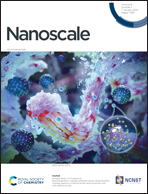High throughput processing of dinaphtho[2,3-b:2′,3′-f]thieno[3,2-b]thiophene (DNTT) organic semiconductors†
Abstract
The deposition of organic semiconductors (OSCs) using solution shearing deposition techniques is highly appealing for device implementation. However, when using high deposition speeds, it is necessary to use very concentrated OSC solutions. The OSCs based on the family of dinaphtho[2,3-b:2′,3′-f]thieno[3,2-b]thiophene (DNTT) have been shown to be excellent OSCs due to their high mobility and stability. However, their limited solubility hinders the processing of these materials at high speed. Here, we report the conditions to process alkylated DNTT and the S-shaped π-core derivative S-DNTT by bar-assisted meniscus shearing (BAMS) at high speed (i.e., 10 mm s−1). In all the cases, homogeneous thin films were successfully prepared, although we found that the gain in solubility achieved with the S-DNTT derivative strongly facilitated solution processing, achieving a field-effect mobility of 2.1 cm2 V−1 s−1, which is two orders of magnitude higher than the mobility found for the less soluble linear derivatives.
![Graphical abstract: High throughput processing of dinaphtho[2,3-b:2′,3′-f]thieno[3,2-b]thiophene (DNTT) organic semiconductors](/en/Image/Get?imageInfo.ImageType=GA&imageInfo.ImageIdentifier.ManuscriptID=D2NR05625A&imageInfo.ImageIdentifier.Year=2023)


 Please wait while we load your content...
Please wait while we load your content...